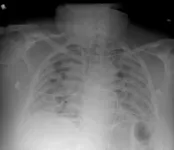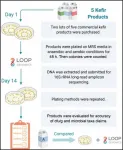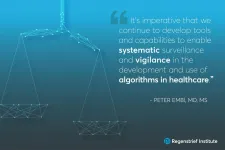Harnessing the hum of fluorescent lights for more efficient computing
2021-05-12
(Press-News.org) The property that makes fluorescent lights buzz could power a new generation of more efficient computing devices that store data with magnetic fields, rather than electricity.
A team led by University of Michigan researchers has developed a material that's at least twice as "magnetostrictive" and far less costly than other materials in its class. In addition to computing, it could also lead to better magnetic sensors for medical and security devices.
Magnetostriction, which causes the buzz of fluorescent lights and electrical transformers, occurs when a material's shape and magnetic field are linked--that is, a change in shape causes a change in magnetic field. The property could be key to a new generation of computing devices called magnetoelectrics.
Magnetoelectric chips could make everything from massive data centers to cell phones far more energy efficient, slashing the electricity requirements of the world's computing infrastructure.
Made of a combination of iron and gallium, the material is detailed in a paper published May 12 in Nature Communication. The team is led by U-M materials science and engineering professor John Heron and includes researchers from Intel; Cornell University; University of California, Berkeley; University of Wisconsin; Purdue University and elsewhere.
Magnetoelectric devices use magnetic fields instead of electricity to store the digital ones and zeros of binary data. Tiny pulses of electricity cause them to expand or contract slightly, flipping their magnetic field from positive to negative or vice versa. Because they don't require a steady stream of electricity, as today's chips do, they use a fraction of the energy.
"A key to making magnetoelectric devices work is finding materials whose electrical and magnetic properties are linked." Heron said. "And more magnetostriction means that a chip can do the same job with less energy."
Cheaper magnetoelectric devices with a tenfold improvement
Most of today's magnetostrictive materials use rare-earth elements, which are too scarce and costly to be used in the quantities needed for computing devices. But Heron's team has found a way to coax high levels of magnetostriction from inexpensive iron and gallium.
Ordinarily, explains Heron, the magnetostriction of iron-gallium alloy increases as more gallium is added. But those increases level off and eventually begin to fall as the higher amounts of gallium begin to form an ordered atomic structure.
So the research team used a process called low-temperature molecular-beam epitaxy to essentially freeze atoms in place, preventing them from forming an ordered structure as more gallium was added. This way, Heron and his team were able to double the amount of gallium in the material, netting a tenfold increase in magnetostriction compared to unmodified iron-gallium alloys.
"Low-temperature molecular-beam epitaxy is an extremely useful technique--it's a little bit like spray painting with individual atoms," Heron said. "And 'spray painting' the material onto a surface that deforms slightly when a voltage is applied also made it easy to test its magnetostrictive properties."
Researchers are working with Intel's MESO program
The magnetoelectric devices made in the study are several microns in size--large by computing standards. But the researchers are working with Intel to find ways to shrink them to a more useful size that will be compatible with the company's magnetoelectric spin-orbit device (or MESO) program, one goal of which is to push magnetoelectric devices into the mainstream.
"Intel is great at scaling things and at the nuts and bolts of making a technology actually work at the super-small scale of a computer chip," Heron said. "They're very invested in this project and we're meeting with them regularly to get feedback and ideas on how to ramp up this technology to make it useful in the computer chips that they call MESO."
While a device that uses the material is likely decades away, Heron's lab has filed for patent protection through the U-M Office of Technology Transfer.
INFORMATION:
The paper is titled "Engineering new limits to magnetostriction through metastability in iron-gallium alloys." The research is supported by IMRA America and the National Science Foundation (grant numbers NNCI-1542081, EEC-1160504 DMR-1719875 and DMR-1539918).
Other researchers on the paper include U-M associate professor of materials science and engineering Emmanouil Kioupakis; U-M assistant professor of materials science and engineering Robert Hovden; and U-M graduate student research assistants Peter Meisenheimer and Suk Hyun Sung.
ELSE PRESS RELEASES FROM THIS DATE:
2021-05-12
Trained to see patterns by analyzing thousands of chest X-rays, a computer program predicted with up to 80 percent accuracy which COVID-19 patients would develop life-threatening complications within four days, a new study finds.
Developed by researchers at NYU Grossman School of Medicine, the program used several hundred gigabytes of data gleaned from 5,224 chest X-rays taken from 2,943 seriously ill patients infected with SARS-CoV-2, the virus behind the infections.
The authors of the study, publishing in the journal npj Digital Medicine online May 12, cited the "pressing need" ...
2021-05-12
The 'missing link' that helped our ancestors to begin communicating with each other through language may have been iconic sounds, rather than charades-like gestures - giving rise to the unique human power to coin new words describing the world around us, a new study reveals.
It was widely believed that, in order to get the first languages off the ground, our ancestors first needed a way to create novel signals that could be understood by others, relying on visual signs whose form directly resembled the intended meaning.
However, an international research team, led by experts from the University of Birmingham and the Leibniz-Centre General Linguistics (ZAS), Berlin, have discovered that iconic ...
2021-05-12
Lancaster scientists have demonstrated that other physicists' recent "discovery" of the field effect in superconductors is nothing but hot electrons after all.
A team of scientists in the Lancaster Physics Department have found new and compelling evidence that the observation of the field effect in superconducting metals by another group can be explained by a simple mechanism involving the injection of the electrons, without the need for novel physics.
Dr Sergey Kafanov, who initiated this experiment, said: "Our results unambiguously refute the claim of the electrostatic field effect ...
2021-05-12
Touchscreens are notoriously difficult to type on. Since we can't feel the keys, we rely on the sense of sight to move our fingers to the right places and check for errors, a combination of efforts we can't pull off at the same time. To really understand how people type on touchscreens, researchers at Aalto University and the Finnish Center for Artificial Intelligence (FCAI) have created the first artificial intelligence model that predicts how people move their eyes and fingers while typing.
The AI model can simulate how a human user would type any sentence on any keyboard design. It makes errors, detects them -- though not always immediately -- and corrects them, very much like ...
2021-05-12
Philadelphia, May 12, 2021 - The COVID-19 pandemic has resulted in an abrupt change in healthcare delivery, including a shift from in-person visits to telemedicine. However, a Canadian survey found that a significant proportion of cardiology trainees are uncomfortable with using telemedicine and feel that better preparation for new-tech medicine is needed. Experts draw attention to the need for a telemedicine curriculum that includes supervision to prepare trainees for the expanding role of telemedicine in cardiovascular care. Survey results are published in the Canadian Journal of Cardiology.
"Our outpatient care shifted almost overnight from in-person visits to providing care to patients via telephone or video platforms (known as telemedicine) as a result ...
2021-05-12
Philadelphia, May 12, 2021 - In recent years there has been an increased interest in the consumption of kefir, a fermented dairy beverage, because there is some evidence that it has health benefits and its affordability. A new study by researchers from the University of Illinois and The Ohio State University, published in JDS Communications, found that 66 percent of the commercial kefir products studied overstated microorganism density and 80 percent contained bacterial species that were not included on the label, potentially misleading consumers.
Senior author Kelly S. Swanson, PhD, University of Illinois, Urbana, ...
2021-05-12
A new study led by the Centre for Nutraceuticals in the University of Westminster shows that pink drinks can help to make you run faster and further compared to clear drinks.
The researchers found that a pink drink can increase exercise performance by 4.4 per cent and can also increase a 'feel good' effect which can make exercise seem easier.
The study, published in the journal Frontiers in Nutrition, is the first investigation to assess the effect of drink colour on exercise performance and provides the potential to open a new avenue of future research in the field of sports drinks and exercise.
During the study participants were asked to run on a treadmill for 30 minutes at a self-selected speed ensuring their rate of exertion remained consistent. Throughout the exercise ...
2021-05-12
For college students under pressure, a dog may be the best stress fighter around.
Programs exclusively focused on petting therapy dogs improved stressed-out students' thinking and planning skills more effectively than programs that included traditional stress-management information, according to new Washington State University research.
The study was published today in the journal AERA Open, a peer-reviewed journal of the American Educational Research Association. The paper demonstrated that stressed students still exhibited these cognitive skills improvements up to six weeks after completion of the four-week-long program.
"It's a really powerful finding," said Patricia Pendry, associate professor in WSU's Department of ...
2021-05-12
Researchers from University of Maryland, North Carolina State University, National Taiwan University, Oxford University, Kings College London, and Perceptronics Solutions, Inc. published a new paper in the Journal of Marketing that examines how artificial intelligence (AI)-based text analysis of social media can monitor the extent to which brand reputation rises and falls over time.
The study, forthcoming in the Journal of Marketing, is titled "Real-Time Brand Reputation Tracking using Social Media" and is authored by Roland Rust, William Rand, Ming-Hui Huang, Andrew Stephen, Gillian Brooks, ...
2021-05-12
INDIANAPOLIS -- Artificial intelligence (AI)-driven healthcare has the potential to transform medical decision-making and treatment, but these algorithms must be thoroughly tested and continuously monitored to avoid unintended consequences to patients.
In a JAMA Network Open Invited Commentary, Regenstrief Institute President and Chief Executive Officer and Indiana University School of Medicine Associate Dean for Informatics and Health Services Research Peter Embí, M.D., M.S., strongly stated the importance of algorithmovigilance to address inherent biases in healthcare algorithms and their deployment. ...
LAST 30 PRESS RELEASES:
[Press-News.org] Harnessing the hum of fluorescent lights for more efficient computing




